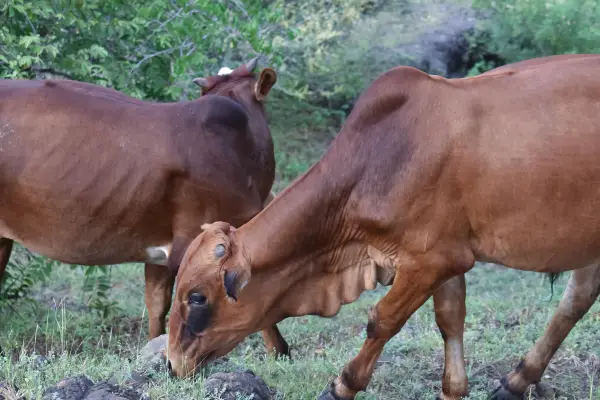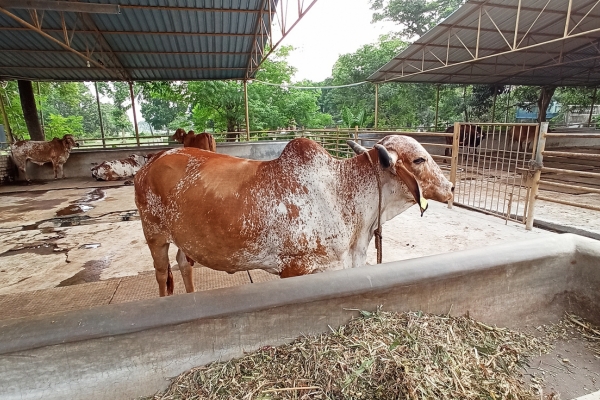Gyr Cattle Breed
Gyr cattle, also known as Gir cows, are an iconic Indian breed renowned for their hardy nature and milk production abilities. As per the 2019 livestock census, the Gyr cattle population stands at over 10 million, making them one of the most popular cattle breeds in India.
But where did these iconic cattle originate, and what makes them a preferred choice among Indian dairy farmers? Let’s find out.
Origin of Gyr Cattle
Gyr cattle originated from the Gir forests of Gujarat, which gives the breed its alternative name of Gir cattle. They have been bred in India for over 4,000 years. Gyr cows belong to the Bos indicus species and are a prominent member of the Zebu cattle family.
Initially bred by pastoral communities in Gujarat, Gyr cattle have now spread across various states of India due to their adaptability to diverse climates. As per Indigenous Bovines Breeders Association data, around 80% of the total Gyr population is now found outside their native Gujarat.
Characteristics of Gyr Cattle
Gyr cows are medium to large-sized animals with distinct physical traits.
- Coat Color and Horns: They have a wheatish to gray coat color, sometimes with white markings on the face, dewlap, and legs. Gyr bulls have distinctive horns curving outward and upward.
- Average Size: Males weigh 500-550 kg, stand at 130-140 cm tall at withers Females weigh 325-375 kg, stand at 115-125 cm tall at withers
- Physical Attributes: Gyr cattle have a deep abdomen, well-sprung ribs, and strong legs with well-set hooves. These conformational characteristics allow Gyrs to walk long distances while foraging. Their skin is loose and supple, helping regulate body temperature.
- Heat Tolerance: Gyr cattle efficiently tolerate heat stress. Their light-colored, short and sleek coat reflects heat away from their bodies. They also exhibit efficient sweating and respiratory heat loss for thermal regulation in hot climates.

Where Are Gyr Cattle Used?
Gyr cows are reared across India as efficient milch breeds due to their superb milk production and reproductive abilities under harsh conditions. Here’s a look at their key uses:
- Dairy Farming: Gyr cattle dominate India’s dairy industry due to their exceptional milk production capacity even on marginal nutrition. Dairy farmers prefer Gyr cows due to lower maintenance and feeding costs compared to exotic dairy breeds.
- Interbreeding Programs: Gyr bulls are interbred with exotic cattle like Holstein Friesian and Jersey cows to impart higher disease resistance, heat tolerance, and survival rates to crossbred offspring. This results in improved milk yields.
- Organic Farming: Gyr cows adapt well to organic production systems. Due to their innate disease resistance and thriftiness, Gyr cattle thrive under low-input organic farming conditions while producing quality milk.
- Draft Power: Male Gyr cattle are used in rural areas for draft purposes like pulling carts or ploughing fields. Their physical strength also makes them good draught animals.
What Is The Milk Production of Gyr Cows?
The average milk yield of Gyr cows may vary from 2,500 to 3,500 kg lactation yield based on factors like nutrition, genetics, lactation stage, etc.
While lower than specialized dairy breeds, Gyr cattle milk has higher fat and SNF content ranging from 4.5 to 5.5% and 8 to 9%, respectively. Due to its rich composition, farmers earn sufficiently more money from selling Gir cow milk compared to regular milk in India.
Additionally, elite purebred Gir cows with excellent genetics can produce 4,000 to 4,500 kg milk lactation yield when properly managed. Hence, selective breeding programs aim to further enhance the milk production potential of Gyr cattle.

What Are The Advantages of Gyr Cattle?
Here are the key merits that make Gyr cattle an ideal breed, especially for rural subsistence farming in tropical regions:
- Exceptional Heat Tolerance: Gyr cattle exhibit tremendous thermotolerance and efficiently regulate body temperature in hot Indian summers where temperatures soar to 48°C in some parts.
- Disease Resistance: Gir cows have high innate resistance to diseases like foot and mouth disease (FMD) along with tolerance for internal parasites. This significantly reduces veterinary care costs.
- Low-Input Husbandry: Gyr cattle are frugal grazers that can thrive on moderate nutrition and basic husbandry practices, reducing overall maintenance costs.
- Long Productive Life: Gyr cows remain reproductively active for 15 years on average, with some producing 20+ calves over their lifespan. This results in sustained milk yields.
- Premium Milk Prices: Thanks to rich milk composition and indigenous breed value, farmers earn 15-60% higher prices for Gir cow milk compared to regular cows.
What Are The Disadvantages of Gyr Cattle?
- Lower Milk Yields: Average Gir cows produce around 50-60% lower milk compared to specialized dairy breeds like Holstein Friesians in intensive production setups. However, fodder requirement is also substantially lower for Gyrs.
- Slow Maturing: Gyr heifers (young females) calve only after 30-42 months compared to 22-24 months for European breeds. However, early conception is not recommended for Gir cows owing to their slow pre-pubertal growth rate.
7 Key Facts About Gyr Cattle
- Native breed of Gujarat, alternatively called Gir cattle
- Renowned as sturdy milch breeds that thrive in tropical Indian climates
- Preferred by smallholder dairy producers due to lower rearing costs and premium milk prices
- Best suited for low-input rural production conditions
- Bulls used for interbreeding programs with exotic cattle
- Milk yield averages 2,500-3,500 kg lactation under field conditions
- Gir cow milk has very high fat (4.5-5.5%) and SNF (8-9%) content
The hardy, tropical-friendly Gyr breed continues to gain popularity across India for sustainable milk production. Their frugal nature, disease resistance and heat tolerance make them an economical asset for smallholder dairy farmers in rural sectors aiming to improve income without high investments. Hence, supporting Gyr cattle development aligns perfectly with improving rural prosperity in India.

